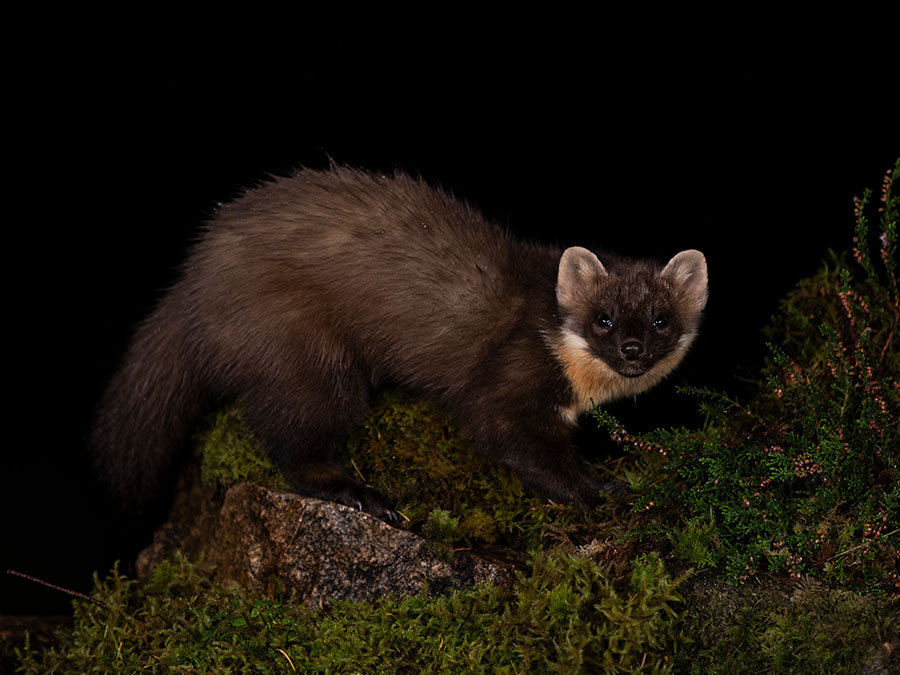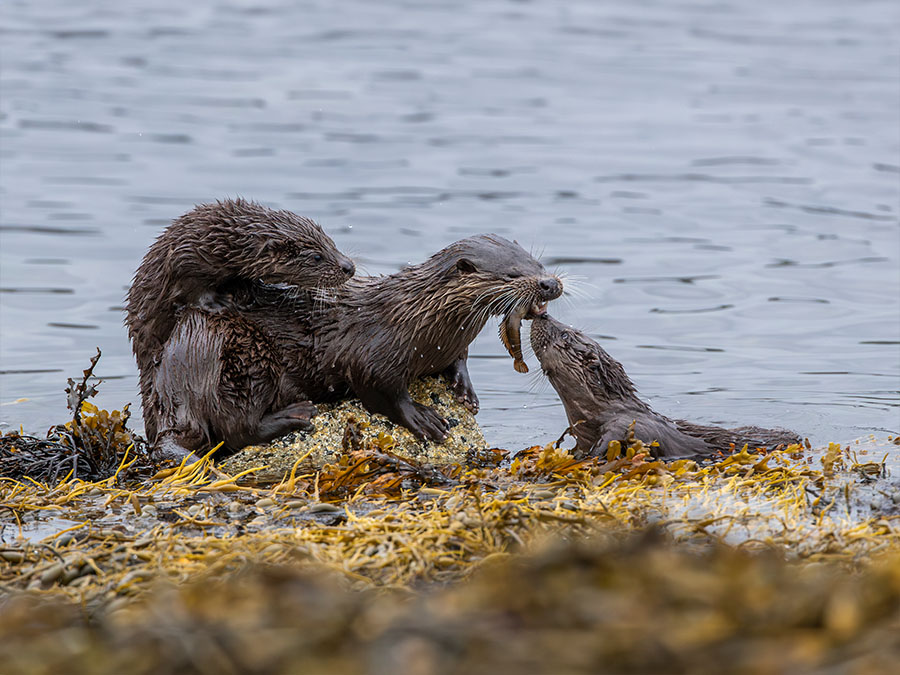In my first article, I wrote about how Lynne and I look forward to our photographic holidays in the Highlands and particularly at Ardtornish. Work commitments mean we can only visit for 1 or 2 weeks at a time. We always want to do so much with the limited time we have, that we have evolved ways of organising ourselves, to get the best photographic results we can.
Planning our trips has always been part of the anticipation and excitement of the holiday itself; often starting weeks beforehand. We use a whole variety of traditional and digital resources. Ordnance survey maps are a great place to start and can reveal so much about an area. We also use ours to collate additional information. I love paper maps, but these days they can all be viewed via online Apps. I also like Google maps, and I’ve thrown their little yellow man out onto remote minor roads all over Scotland to carry out some virtual reconnaissance!
Our paper maps end up with lots of coloured stickers on them, to highlight significant areas to visit. We read general guidebooks and more specialist photography books – and any useful information we find is marked on the map with a sticker. We have our own system of colour coding; with sites for birds marked one colour, animals another and potential landscape photo opportunities another again. If we run out of colours, then we change sticker shape! All a bit random, but it works for us. And if we do forget what each colour means, we have fun trying to work it out.
Some of the books we find useful, particularly when visiting somewhere new are: Photographing Scotland by Dougie Cunningham, Photographing Wildlife in the UK by Andrew Marshall and probably our most useful resource, the Scottish Highlands Best Birdwatching Sites guide by Gordon Hamlett.
We also find and follow Facebook and Instagram pages that focus on local wildlife. These are particularly useful for the regular and often detailed reports of sightings they publish. For example, Mull Nature Watch; Ardnamurchan Wildlife Watch; and Highland and Moray Bird News all receive frequent posts.
Other useful bits of planning information can be found via online apps. We use Moonrise for predicting sunrise and sunset, and a variety of weather apps including Accuweather and Clear Outside. Then there’s AuroraWatch UK which can be set to automatically send alerts to a phone when the aurora may be visible (we’re still waiting for that perfect photo of the northern lights over Ardtornish). Some of the more specialised photography apps such as Photo Pills are also useful, although they have to be paid for.
Once we know where we are going to be visiting, and when, we can start researching in earnest, to maximise our photo opportunities.
Knowing the moon phase during our stay helps in a number of ways. Some animal and bird behavior may be influenced by it. Wild geese often flight and feed under a full moon for example, so their daytime activity may be unpredictable. Too much moonlight might allow otters to hunt at night, or prevent more cautious nocturnal visitors from coming close to houses. And the moon also dictates the tidal cycle, which has an impact on how some of our target species, such as otters hunt and feed. We use an app called Tide Pro which gives detailed timetables for a chosen location, but there are others.
We always have a list of the animals and birds we hope to see, as well as some photographic goals mapped out well in advance. For example, our list for a visit to Ardtornish in autumn might include:
Rutting stags: Portrait and wider angle shots of them bellowing, fighting, rounding up hinds and mating.
Pine marten: Portrait and wider angle context shots hopefully including this year’s kits, showing interactions between multiple animals, with a variety of lighting and possibly backlit silhouettes.
Red squirrel: Wider angle shots in the canopy and on the ground, feeding, caching nuts and portraits hopefully with “ear tuft” portraits.
Otter: Wider angle and close up shots of mums with cubs, playing/fighting, grooming, fishing, and feeding with detailed portraits if the catch is exotic or unusual.
I hope to look at each of these species individually in future blogs. There may be other targets on our list, but even focusing on just these 4 will keep us busy all holiday.
We have most success with red deer activity at dawn and dusk. Time spent in reconnaissance is never wasted, and we will make a note of anywhere we see (or hear) deer whenever we are out and about driving or walking.
We will often get to a likely spot well before sunrise, so that we can be in position as the sun rises; hopefully illuminating the deer activity with some beautiful golden light. Late evening, as the sun sets is also a good time. The best opportunities often present themselves when it’s almost too dark to take a photo, and at that time of the morning or evening, the deer can sometimes be found quite close to roads.
It’s worth bearing in mind that sporting estates are likely to be shooting surplus stags at this time of year as part of their management cull, so we always try to check that we aren’t going anywhere that might interfere with that (or put ourselves at risk).
Pine marten can often be photographed during the daytime in summer, particularly when a mother is feeding young kits, or when those kits are older and start to venture out of the nest with her, or by themselves. But by autumn, they return to a largely nocturnal lifestyle, so we have to adapt to photographing them in the dark. We go about this in a number of ways.
Pine Marten can be quite inquisitive and confiding animals, and we spend the first couple of days of any holiday trying to win their trust. We will put out suitable food such as peanuts, raisins, honey, even the occasional roadkill small bird, (but not jam sandwiches!) We have even been known to take a bag of the frozen mice that pet shops sell as lizard food with us.
We initially monitor the level of activity with strategically placed trail cameras. When we know the pine marten are visiting regularly, we try to gradually introduce some light. Experience shows that provided we don’t rush the process, or turn the lights up too far, then the pine martens quickly accept the situation and will happily visit for long periods allowing for some great photo opportunities. There will always be the odd individual that is more cautious and wants to stay in the shadows, but then there’s also the occasional precocious one; that tries to climb in through the kitchen window to tell you when the food has run out!
A number of red squirrels were released into the Ardtornish grounds a few years ago. They seem to have settled in well and appear to be breeding and extending their number and range (we’ve seen one several miles away from Ardtornish along the Drimnin road).
In autumn squirrels spend a lot of time feeding in preparation for the long winter ahead. They also cache food to last them through those lean times. As we walk around the estate, we’re always on the lookout for hazel trees with good crops of nuts. A little bit of time spent watching such a tree will soon show if the squirrels have found it yet. If they have, they will make regular visits, often arriving and leaving the same way. They may also start to bury nuts quite close by.
Sitting quietly against a tree wearing drab coloured clothing will usually be enough to allow them to go about their business without feeling threatened. We do have a small pop-up tent hide that we can erect quickly if we need extra camouflage. Peak activity seems to be around mid-morning and mid-afternoon with a lull around lunchtime.
If we’re lucky enough to be staying in Keeper’s Cottage, there are a few nut trees around the garden. If our stay coincides with those nuts ripening, then we have the luxury of being able to photograph the visiting squirrels from the comfort of the cottage.
There are otters in Loch Aline, and over the years, we’ve seen them pretty much anywhere, from the bridge by the castle to the ferry. It’s also easy to visit Mull for the day. We know several areas there where the rocky shoreline is easily accessible and offers more hiding places near to the tideline.
Knowing the state of the tide increases the chances of success. We have found that otters tend to be more active in the period of 2 or 3 hours either side of low tide (but having said that we have seen them at all states of the tide). The absolute prime time is when that window coincides with dawn, so there is a chance of some wonderful golden light. The other major advantage is that there is less chance of disturbance, as most ‘normal’ people are still in bed.
You can’t really influence an otter’s behavior (other than by scaring it away). As a result, it’s difficult to plan encounters with them, apart from being in a likely spot at the right time. Taking wind direction into account may mean an otter comes closer to your hiding spot. An understanding of their behavior; how long they spend in the water at a time; how they hunt; and how long they can stay submerged will help you predict where your hiding spot should be and help you get there unseen.
An otter will often head for the shore when it catches something substantial or awkward to eat. Hopefully it will also be something photogenic, like an octopus or a large lobster). Knowing this allows you to try and predict where it might land, so you can get hidden somewhere close well before it arrives. Sometimes you guess right; often you’re hoping for better luck next time!
Our one overriding thought when trying to photograph otters is that we should not disturb them, or prevent them from finding enough food for themselves and any dependent cubs. There’s an enormous amount of satisfaction to be gained from getting it right, watching and photographing an otter family for a couple of hours, and then sneaking away without them ever being aware of our presence.
I hope to cover each of these photographic subjects in more detail in future articles and expand on the camera set ups and techniques we use. But in the meantime, our first trip of the year is drawing ever closer. It’s only a few weeks until we visit an area of the Highlands we’ve only ever driven through before, but never really explored. So, we’re already well into the detailed planning phase, our new maps are looking suitably spotty, and our list of possible targets is growing by the day.
Wish us luck!









